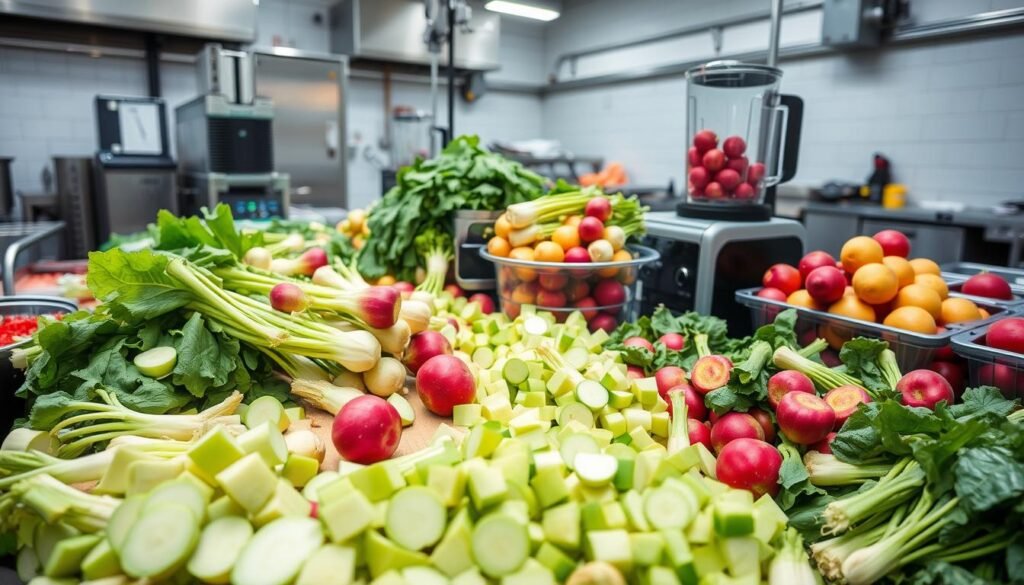Have you ever wondered why kohlrabi is becoming a hit in healthy eating and new food products? We’re diving into kohlrabi processing, looking at how to turn this versatile veggie into tasty treats. From kohlrabi chips to pickled goodies, the possibilities for creativity and profit are huge.
In this article, we’ll explore different processing methods, key equipment, and market trends. We’ll look at project economics, equipment needs, and investment chances. This guide is for anyone interested in kohlrabi processing, helping you understand its potential.
Key Takeaways
- Kohlrabi processing includes methods such as slicing, pickling, and freezing.
- The slicing machine can output 600-800 kg/hour, enhancing productivity.
- Market growth for kohlrabi products is projected at a 6% CAGR through 2028.
- 40% of kohlrabi is processed into various consumables, including fresh-cut and frozen products.
- Efficient machinery can reduce processing costs by up to 25% while increasing output.
Introduction to Kohlrabi
Kohlrabi, known as Brassica oleracea var. gongylodes, has a long history in European cuisine. It’s a unique vegetable, often compared to cabbage and broccoli. First grown in Europe, it has spread to Asia and the world, loved for its adaptability and taste.
The Fascinating History of Kohlrabi
Kohlrabi started in Eastern Europe in the 16th century. Its popularity grew as more cultures enjoyed its taste and texture. It’s a staple in German dishes and modern cooking, loved globally. In the UK, it’s available from late spring to autumn, but you can find it all year.
Varieties of Kohlrabi and Their Uses
There are many kohlrabi varieties, each with its own taste and texture. You’ll find purple and green-skinned ones, perfect for salads or cooked dishes. Kohlrabi stays tender and tasty even when it’s big, making it a favourite among chefs and home cooks.
Understanding Kohlrabi Processing Techniques
We explore how kohlrabi is transformed from raw to various products. These methods improve taste, extend shelf life, and meet health needs. We aim to understand these techniques and their benefits.
Overview of Processing Methods
Kohlrabi goes through several steps to keep its quality. First, it’s washed and peeled for cleanliness. Then, it’s cut and sliced for different uses.
- Washing and peeling to ensure cleanliness and remove the tough outer layer.
- Cutting and slicing into various shapes for diverse culinary applications.
- Preservation methods including canning and pickling to extend shelf life and create exciting new flavours.
Processed kohlrabi comes in many forms, like chips and pickles. These options are great for those looking for healthy snacks.
Benefits of Processing Kohlrabi
Processing kohlrabi has many advantages. It makes the vegetable last longer, up to a week when stored right. Cooked kohlrabi stays fresh for days in sealed containers.
It also keeps important nutrients like fibre, vitamins, and minerals. A kohlrabi bulb has:
- 41 calories
- 9 grams of carbohydrates
- 3 grams of protein
- 525 milligrams of potassium
- 5 grams of dietary fibre
- 93 milligrams of Vitamin C
It’s also very versatile in cooking. Roasting kohlrabi takes 30 to 35 minutes and makes a tasty side dish. We can even make kohlrabi fries for plant-based meals. This meets consumer demand for healthy, tasty options.
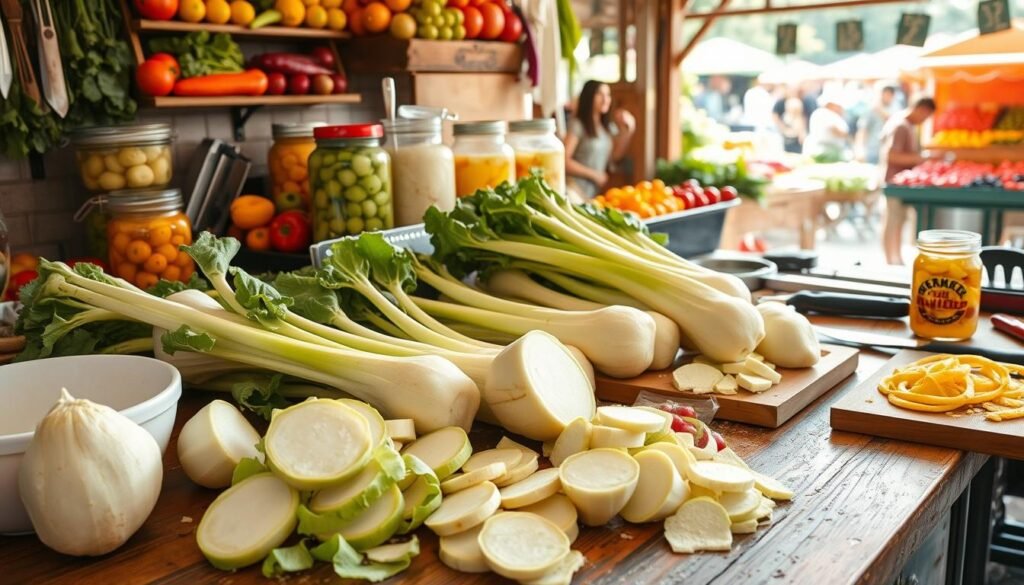
Kohlrabi Processing: Techniques, Equipment, and Market Opportunities
To improve kohlrabi processing, we need the right equipment. Quality cutting and slicing tools are key. They make preparation faster and help us create new kohlrabi products. The Li An Root Vegetable Cutting Machine is a great example. It can handle lots of kohlrabi, meeting market needs.
Essential Cutting and Slicing Equipment
Choosing the right cutting and slicing tools is crucial. They affect how much we can produce and the quality of our products. Here are some important features and benefits of kohlrabi processing equipment:
| Equipment Type | Output Capacity (kg/hour) | Power Consumption (kW/380V) | Dimensions (mm) | Weight (kg) |
|---|---|---|---|---|
| Slicing Machine | 600-800 | 0.75 | 600 x 800 x 1050 | 100 |
Using advanced machines helps us prepare kohlrabi quickly and try new product ideas. With the right tools, we can offer a range of products. This includes snacks, side dishes, and healthy options, matching what customers want.
Innovation in Kohlrabi Product Development
Innovation is key to success in the kohlrabi market. New products use modern tech and manufacturing. This lets us create unique dishes. For example, we can make innovative snacks from kohlrabi, meeting health trends.
The need for different kohlrabi products is growing. By innovating, we stay ahead and meet new customer needs.
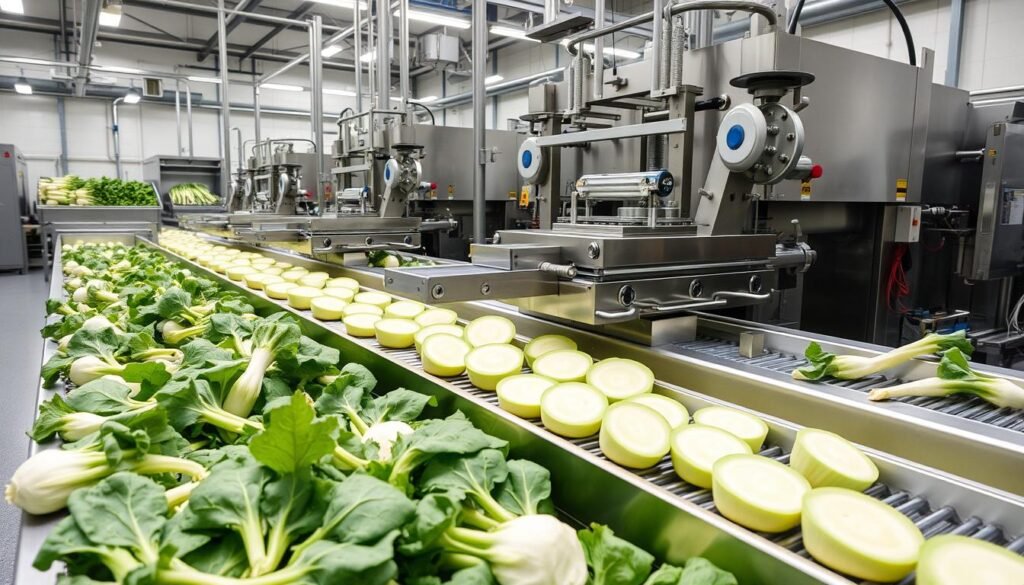
Market Trends in Kohlrabi Products
As food trends change, more people want kohlrabi, a healthy and tasty veggie. This shift towards better eating habits boosts interest in kohlrabi. Looking closely at kohlrabi market trends shows a big growth chance, thanks to different regional insights.
Consumer Preferences and Demand
The kohlrabi market is growing fast. In the US, we now see about 100,000 tons of kohlrabi each year. This is a 15% jump in five years.
More people are choosing kohlrabi for its health benefits. About 70% of buyers say they pick it for its nutritional value. Fresh kohlrabi costs around $1.50 per pound, while processed types can go up to $3.00 per pound.
Regional Market Insights for Kohlrabi
Europe is a big player in the kohlrabi market, making up 60% of sales. This is because Europeans love organic foods. The processing side of kohlrabi is expected to grow, with 35% of the market share.
Online shopping for kohlrabi has jumped by 40% in two years. This shows a big change in how people buy food online. Also, big brands have brought out over 30 new kohlrabi products in just one year. This shows the industry’s creativity and ability to adapt.
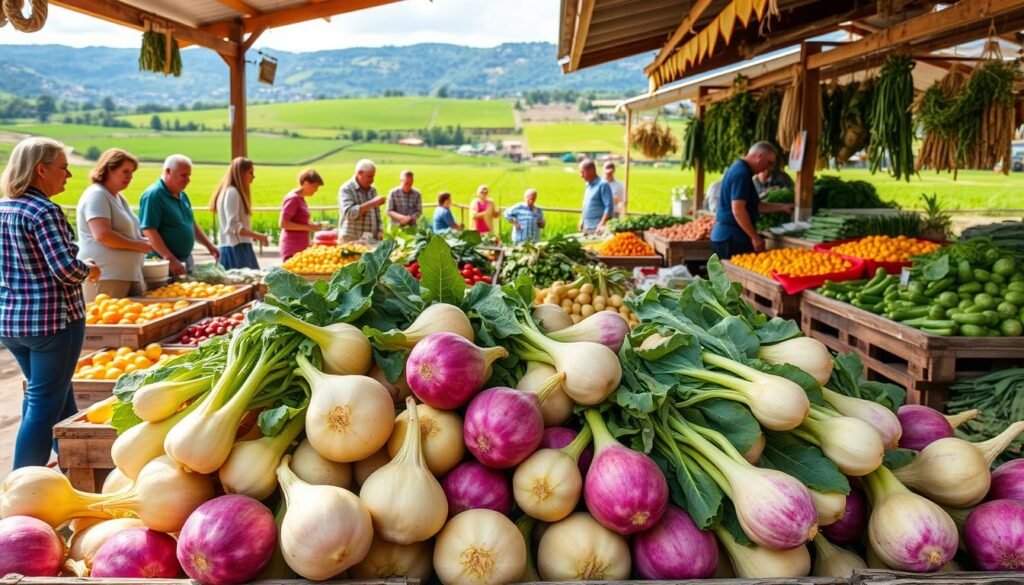
| Statistical Insight | Value |
|---|---|
| Projected CAGR (2023-2028) | 4.3% |
| Total Production (US) | 100,000 tons |
| Market Share (Processing Segment) | 35% |
| Retail Price (Fresh Kohlrabi) | $1.50 per pound |
| Retail Price (Processed Kohlrabi) | $3.00 per pound |
| Proportion of Production for Processing | 25% |
| New Products Launched (Last Year) | 30+ |
Utilising Technology in Kohlrabi Processing
Exploring technology in kohlrabi processing shows how important new machinery is. It helps us make better products. The latest machines make our work easier and faster, helping us keep up with what customers want.
Advancements in Processing Machinery
The Li An Machinery CT-212 has a strong 7.5 kW (10 HP) motor. It keeps the product cool, which helps keep its quality.
Automation in Kohlrabi Production
Automation has changed kohlrabi production a lot. Tools like the Li An Machinery make quick changes easy. This means we can work on different types of produce faster, saving time and boosting productivity.
The SnackPro 1 fryer is made for frying snacks like kohlrabi. It has 90 kW heating elements and a double oil filtration system. This means better quality snacks and lower costs. Machines like these help us do more with less oil.
As the industry grows, using the latest machinery and automation helps us stay ahead. It leads to sustainable growth and keeps us competitive.
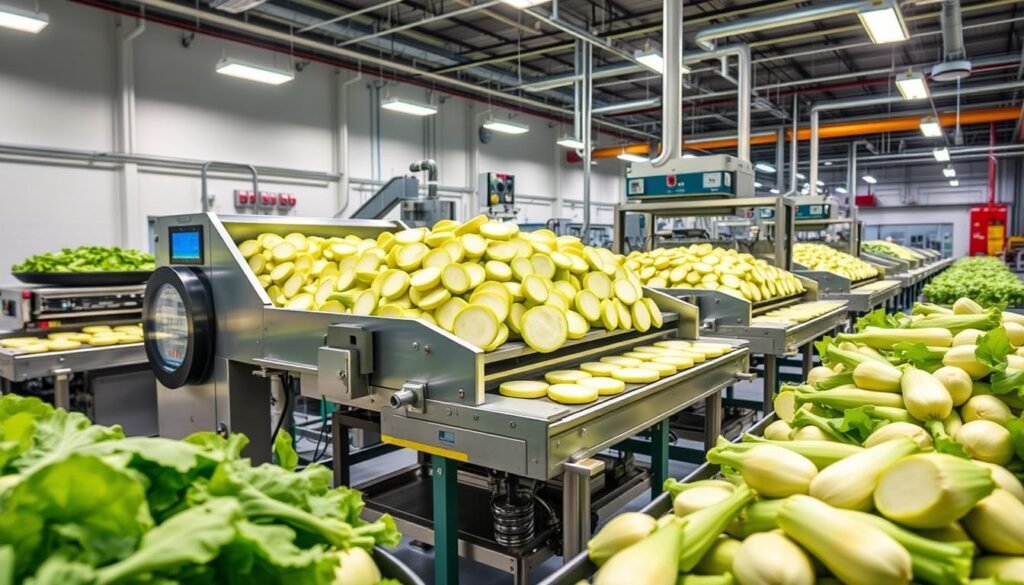
Economic Considerations in Kohlrabi Processing
Understanding the economic side of kohlrabi processing is key for those thinking about getting into this market. We often get asked about the economic side of kohlrabi processing. The investment in the kohlrabi market is growing fast, thanks to more people wanting new vegetable products. This part looks at the investment chances and the costs that investors need to think about.
Investment Opportunities in the Market
The interest in kohlrabi is on the rise, showing there are chances for making money. Investors can look into different areas, like:
- Creating new kohlrabi products, like snacks and meals ready to eat.
- Looking into exporting to places where health foods are in demand.
- Using green processing methods to meet the growing demand for eco-friendly products.
This growing interest means we need to do a deep dive into the economics of kohlrabi processing. This will help make sure the investment is worth it. With good planning, you can find a spot in a competitive market.
Cost Analysis for Setting Up Processing Plants
When it comes to kohlrabi processing, the costs are a big deal. Knowing the costs of setting up a plant is key for planning your budget. The main costs for starting a plant include:
| Cost Category | Estimated Costs (AUD) |
|---|---|
| Infrastructure and Facilities | 200,000 – 500,000 |
| Machinery and Equipment | 150,000 – 400,000 |
| Raw Materials (Initial Stock) | 50,000 – 150,000 |
| Utilities and Operational Costs | 30,000 – 100,000 per year |
| Human Resources | 80,000 – 200,000 per year |
This breakdown is a starting point for investors to match their financial plans with real-world numbers. As we dive into this market, managing costs and finding new solutions will be crucial for success.

Conclusion
Kohlrabi is a key player in the food world, thanks to its health benefits and many uses in cooking. The growing demand for kohlrabi chips shows people want healthier snack choices. This trend looks set to boost the kohlrabi chip market.
Looking at how kohlrabi is processed, market trends, and economic forecasts, we see a lot of potential. The future of kohlrabi products is looking good. We can explore new markets and offer more kohlrabi options by using new methods and meeting changing needs.
As we move ahead, focusing on sustainability and using the latest technology will be crucial. By being innovative and efficient, we can make the most of the kohlrabi industry’s growth.
FAQ
What is kohlrabi, and how is it used in cooking?
Kohlrabi is a vegetable with a crisp texture and mild flavour. It’s great raw in salads or cooked in curries and stir-fries. It’s a favourite in many cuisines.
What processing techniques are used for kohlrabi?
Kohlrabi is washed, peeled, cut and sliced for processing. It’s also canned and pickled to extend its shelf-life. This creates products like kohlrabi chips and pickled kohlrabi.
What equipment is essential for processing kohlrabi?
You’ll need washing and peeling machines, and cutting and slicing tools. The Li An machinery Root Vegetable Cutting Machine is a good example. Modern machinery is key for efficient processing and quality products.
Are there health benefits associated with consuming kohlrabi products?
Yes, kohlrabi products are full of dietary fibre, vitamins, and minerals. They’re a healthy choice for those watching their diet. Even processed forms, like kohlrabi chips, keep many of these benefits.
What are the market opportunities for kohlrabi products?
The demand for healthy eating and unique vegetables is growing. This creates big opportunities for kohlrabi products. Kohlrabi chips and pickled kohlrabi are becoming popular snacks and side dishes.
How does technology impact kohlrabi processing?
New technology, like automation, makes kohlrabi production more efficient. It streamlines tasks from planting to packaging. This improves product quality and cuts costs.
What financial considerations should one keep in mind for kohlrabi processing?
Important financial factors include initial investment, expected returns, and ongoing costs. Analyse expenses for infrastructure, machinery, and staff to ensure profitability.
Source Links
- PDF – https://www.sciencepub.net/nature/ns0908/27_6344ns0908_149_157.pdf
- Home Canning of Vegetables | New Mexico State University – https://pubs.nmsu.edu/_e/E307/index.html
- How to Cook Kohlrabi – https://www.joskitchenlarder.com/how-to-cook-kohlrabi/
- What Is Kohlrabi? Nutrition, Benefits, and Uses – https://www.healthline.com/nutrition/kohlrabi
- Fried Kohlrabi with Cilantro Yogurt Dipping Sauce | Foodal – https://foodal.com/recipes/appetizers/fried-kohlrabi/
- Growing Great Brassicas in Alaska – https://www.uaf.edu/ces/publications/database/gardening/growing-great-brassicas.php
- French fries paddle fryer / Potato chips continuous fryer – https://foodtechprocess.com/en/fryers/304-continuous-paddle-fryer-snackpro.html
- Genus Brassica By-Products Revalorization with Green Technologies to Fortify Innovative Foods: A Scoping Review – https://pmc.ncbi.nlm.nih.gov/articles/PMC9914545/
- World Bank Document – https://documents1.worldbank.org/curated/en/571701467997612428/pdf/FAU12.pdf
- Plant Propagation – Cooperative Extension: Garden and Yard – University of Maine Cooperative Extension – https://extension.umaine.edu/gardening/manual/propagation/plant-propagation/
- HOW TO COOK EVERYTHING – The Culinary Exchange – http://www.theculinaryexchange.com/cook/
- EP2624710A1 – Processing of whole fruits and vegetables, processing of side-stream ingredients of fruits and vegetables, and use of the processed fruits and vegetables in beverage and food products – https://patents.google.com/patent/EP2624710A1/en
- US10334870B2 – Processing of whole fruits and vegetables, processing of side-stream ingredients of fruits and vegetables, and use of the processed fruits and vegetables in beverage and food products – https://patents.google.com/patent/US10334870B2/en

